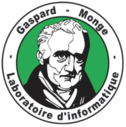PhD Defense Yongchao Xu
From LRDE
Abstract:
This PhD work presents a versatile framework dealing with tree-based image representations. Those representations have been proved to be very useful in a large number of applications. Notably, in mathematical morphology, those representations form the basis for efficient implementation of connected operators. Connected operators are filtering tools that act by merging some elementary regions of an image. A popular filtering strategy relies on (1) building a tree representation of the image; (2) computing a shape-based attribute on each node of the tree; and (3) removing the nodes for which the attribute is too low. This operation can be seen as a thresholding of the tree, seen as a graph whose nodes are weighted by the attribute function.
Rather than being satisfied with a mere thresholding, we propose to expand on this idea. We define the notion of tree- based shape spaces as seeing a tree as a graph whose neighbourhood is given by the parenthood relationship. Then we apply some connected filters on such shape spaces. This simple processing, that we call "shape-based morphology", has several deep consequences. Firstly, it is a generalization of the existing tree-based connected operators. Besides, it allows us to propose two new classes of connected operators: shape-based lower/upper levelings and shapings. Secondly, this framework can be used for object detection/segmentation by selecting relevant nodes in the shape space. Last, we can also apply this framework for transforming hierarchies using extinction values, so that we obtain some hierarchical image simplification and segmentation methods.
We have developed several applications using this framework.
- A first one is a truly contrast invariant local feature detection method called Tree-Based Morse Regions (TBMR), which can be seen as a variant of MSER with better performances.
- Some applications to retinal image analysis (including blood vessel segmentation and optic nerve head segmentation) have been developed using shape-based lower/upper levelings.
- We have also proposed an efficient image simplification method by minimizing the Mumford-Shah functional, which belongs to the shaping family.
- An object detection scheme have been developed by defining an efficient context-based energy estimator.
- Last, we have proposed an extension of constrained connectivity based on our novel hierarchy transforms.
Keywords: Image processing, mathematical morphology, connected filters, tree representations, hierarchies.
Composition du Jury :
- NAJMAN Laurent , Directeur de thèse, Professeur, ESIEE Paris
- GÉRAUD Thierry, Codirecteur de thèse, Professeur, EPITA
- SALEMBIER Philippe, Rapporteur, Professeur, Universitat Politècnica de Catalunya
- MOISAN Lionel, Rapporteur, Professeur, Université Paris Descartes
- SERRA Jean, Examinateur, Professeur émérite, ESIEE Paris
- BALLESTER Coloma, Examinatrice, Professeure, Universitat Pompeu Fabra
- WILKINSON Michael H.F., Examinateur, Enseignant Chercheur, Rijksuniversiteit Groningen
- MARCOTEGUI Beatriz, Examinatrice, Maître de Conférence, Mines ParisTech
- MONASSE Pascal, Examinateur, Chargé de Recherche, Ecole des Ponts ParisTech





